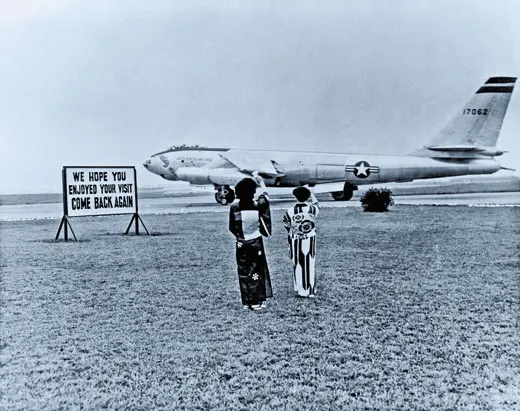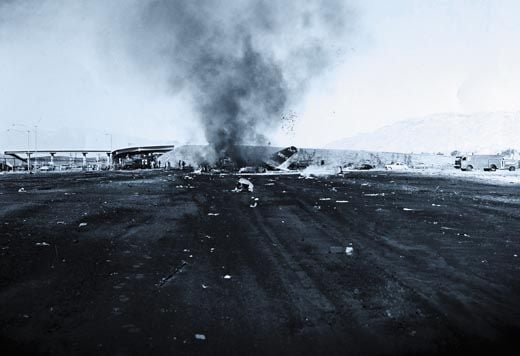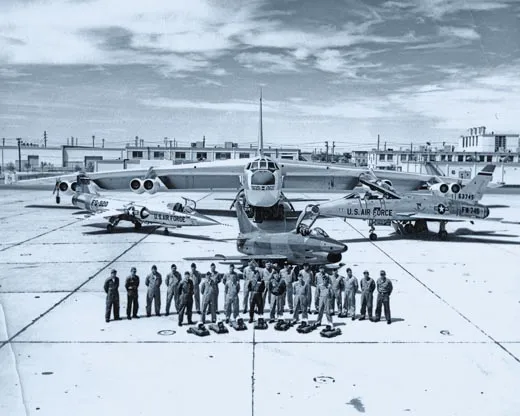The Dawn of Discipline
A B-47 pilot remembers when an airplane—and Curtis LeMay—stiffened the spine of the Strategic Air Command.
/https://tf-cmsv2-smithsonianmag-media.s3.amazonaws.com/filer/Arch_B47_Flash_JJ09.jpg)
I got my first glimpse of a Boeing B-47 on an April morning in 1954, when I was a U.S. Air Force first lieutenant with about 450 hours in bombers. I was walking out to fly a rather staid base aircraft, a Beech C-45, and saw the B-47—glistening in the California sun and trailing long plumes of exhaust—land at my home station, Castle Air Force Base, the first of the 45 to be assigned there.
I’d seen photographs of the bomber and read about its potential. The first time I saw the real thing, though, I was racked with envy, for at that moment, there was little prospect of my flying the B-47. (No one but Boeing publicists ever called it the Stratojet.) I was in the process of becoming an aircraft commander in the Boeing B-50, an upgraded version of the B-29, and the new, super-hot, Jet Age B-47 required even its copilots to have far more flying time than I had.
But being young and foolish had some virtues. Only weeks later, after seeing the majority of my pilot friends in the 330th Bomb Squadron sent off to McConnell Air Force Base in Wichita, Kansas, for B-47 training, I stormed into the ancient Quonset hut that served as the squadron commander’s office to demand that I too be sent.
Fortunately, the commanding officer wasn’t in (he would have thrown me out on my ear). After I pounded on the adjutant’s desk, the good-natured officer immediately had orders cut to send me on my way to meet an aircraft that I would come to love. In the intervening decades, the B-47’s airliner offspring have turned us into a nation of jetsetters, making it difficult to convey just how thrilling the prospect of flying the jet was to a young bomber pilot. (Perhaps more remarkable, today’s commercial transports exceed the subsonic performance envelope of the B-47 by only a small margin.)
In the early years of the cold war, B-47s served as the spearhead of the Strategic Air Command, with the bomber fleet varying in size from 1,000 to more than 1,500 B-47s. We felt that we were the premier force, an unsolvable problem for the Soviet Union. Each B-47 carried as much firepower as a thousand World War II-era B-17s and B-24s, and each was capable of penetrating to the heart of enemy territory. The pleasure we found in flying the airplane, however, was not in its capacity for lethal warfare but rather its sparkling performance. In the early 1950s, freed from banging piston engines and whirling propellers, you sat under a beautifully streamlined canopy, peering out at thousands of square miles of territory, cruising along at seven miles a minute in a jet bomber. It was intoxicating.
My wife Jeanne was not happy with my volunteering to fly the airplane. By 1954, everyone, including pilots’ families, knew that this aircraft, while magnificent, was also very unforgiving. The B-47’s cutting-edge design pushed the boundaries of both aerodynamics and pilot experience. Yet for young pilots eager to enter the Jet Age, knowing that the aircraft could be difficult heightened the pleasure of flying it.
When the B-47 was introduced, it was simply too radical in its aerodynamics and in its demands for unrelentingly professional airmanship. The new United States Air Force was still operating under World War II attitudes. New swept-wing jets demanded much higher standards, yet far too little emphasis was placed on safety and rigorous training. Accident rates and fatalities skyrocketed. The B-47 was unusual in that through 1955, the accident rate rose with the number of flying hours, then stabilized for four years (see “A Dangerous Ride,” p. 67). From 1959 through 1962, the rate shot up again when structural fatigue and revised tactics imposed new stresses.
In 1957, there were 28 fatal accidents and 63 deaths. The common denominator of the accidents was that the circumstances were routine, familiar. In case after case, there was some minor but fatal human error. In a fast instrument let-down, the pilot might turn the wrong way and run into a mountain. Misreading an altimeter led to a smoking hole in the ground. A 15-second lapse of attention in a descending turn could let airspeed build so fast that a safe recovery was impossible. In earlier, more forgiving aircraft, these mistakes might have been survivable, but in the B-47, they were disastrous. Some accidents were caused by maintenance errors, but these were less common. All too often the accident investigation ended with the heartless but accurate phrase “pilot error.”
In today’s Air Force, where bombers are few and terribly expensive, an accident rate approaching that of the B-47 would be unacceptable, and Congress and the public would be justifiably up in arms. In the early days of the cold war, however, it was just business as usual.
To the bomber pilots who flew the aircraft, the B-47 offered fighter-like performance, a vast improvement over the B-29s and B-50s we had been flying. Besides its swept wings and six jet engines slung in pods beneath the wings, the B-47 was unusual in other ways. Its bicycle-style landing gear had it rest on the ground in takeoff attitude, stabilized by two outrigger gear. The high-aspect-ratio wings, spanning 116 feet, were very thin and flexible, so much so that in turbulence it sometimes seemed as if a vibrating outboard engine might simply rumba off the wing. The wings were too thin to serve as tanks, so fuel had to be stored in the fuselage (and in wing drop tanks), and fuel management, particularly during aerial refueling, was critical to maintain the proper center of gravity.
Because of the B-47’s weight (sometimes exceeding 200,000 pounds), the takeoff roll had to be augmented by water-alcohol injection and even, sometimes, by rocket-assisted takeoff. The XB-47 was so advanced that even its designers didn’t know what to expect; one of them told me that when he watched it taxi on its first takeoff, he was not absolutely sure it would fly.
But fly it did, on December 17, 1947, with Bob Robbins and Scott Osler at the controls. The first flight, a 52-minute cruise from Seattle’s Boeing Field to Moses Lake, Washington, was uneventful, and the aircraft embarked on a promising but troubled development period before it entered service. (Sadly, Osler later died in a B-47 canopy malfunction.)
The introduction of the B-47 coincided with the massive makeover of the Strategic Air Command by General Curtis E. LeMay. He assumed command of SAC in 1948, and found that the pell-mell of post-World War II demobilization had left it in shambles. SAC had become a comfortable Air Force-subsidized flying club, where discipline was slack, standards low, and procedures wildly variant. LeMay began an intensive effort to acquire modern aircraft, standardize procedures, improve training, and impose an iron discipline. Although he was successful, the transformation took time.
Joining the 93rd, I entered SAC at the very end of the command’s flying club heyday. While the B-50 was a good aircraft, many of the crew members were World War II veterans who were not yet impressed by the stern demands of a non-shooting cold war. As an example, my first flight as a B-50 copilot included a gunnery mission. During the preflight, I observed boxes of ammunition being loaded into the cavernous bomb bay. With the ignorance of youth, I approached the senior gunner and deferentially asked, “Sarge, wouldn’t it be better to load the ammunition in the fuselage, so we won’t have to depressurize to get it?” He smiled and said, “Don’t you worry about it Loooooootenant.” (Veteran non-commissioned officers could put an inflection on the word that revealed your insignificance.)
Midway through the mission, we flew out to the bombing range off Point Mugu, opened the bomb bay doors, and jettisoned the ammunition boxes. The gunners marked their firing score as 100 percent (and they didn’t even have to clean the guns). Similar light-hearted chicanery went on with the radar bomb scoring, the navigation legs, and so on, until one Monday morning we went to work and found the old leaders had been fired and a whole new management team put in charge. As had happened elsewhere in SAC, base by base, flying went from sometimes frivolous fun to the serious pursuit of the mission.
As he molded SAC to his standards, LeMay was largely responsible for converting the B-47s from maintenance-plagued, accident-prone nightmares into a fleet of the most powerful bombers the world had yet seen. At its peak, SAC employed 1,560 B-47s, primarily as nuclear bombers but also for reconnaissance and electronic warfare. Their projection of power deterred the Soviet Union’s huge army from overrunning Western Europe. Although none of us was privy to the entire war plan, we believed that in less than a week our B-47s could roll up the Soviet Union from the outside in, cutting off its invading armies and ending the war.
In May 1954, I arrived at McConnell Air Force Base and was crewed up with two fine officers, Major Harold McCarty, the aircraft commander, and Captain John Rosene, the radar observer. They were probably not too thrilled to have a low-time copilot on board, but they were polite.
The instructors were very experienced, and during training, they pointed out what made the B-47 capable and what made it dangerous. One of the most talked-about of the latter qualities was the fabled “coffin corner,” a point in the flight when the aircraft’s weight and altitude rendered the difference between a high-speed stall and a low-speed stall negligible. Recovering from a high-speed stall required a swift reduction in power to allow the speed to bleed down to a point where you re-established control. Recovering from a low-speed stall was more conventional. You lowered the nose and applied power, if necessary. The trick was to recover from one without transitioning into the other. In my view, the danger of the coffin corner was overblown, for if you executed correctly a well-planned mission, you would not find yourself in a situation where it might occur.
Flight control issues were far more important, especially the need to react with the correct control inputs if you lost an outboard engine as you neared the takeoff point. The loss of power on the far right (number six) engine, for example, would cause a loss of lift on the right wing, initiating a roll to the right. In a piston-powered aircraft, the traditional reaction was to turn the control wheel to the left, which raises the left aileron and lowers the right one, thus raising the right wing. In the B-47, however, the correct procedure was to boot in rudder pressure to lift the right wing, and you had to do it within 1.7 seconds of the loss to be effective.
Many a squadron briefing was spoiled by film clips of heavily laden B-47s caught at the wrong moment: as an engine failed on takeoff. The films would show the wing going down, the wrong control inputs applied, and then a veering, bounding cartwheel ending in a huge explosion, a sea of flames, and deaths.
But despite the dangers and the new techniques required, flying the B-47 was a joy. Far more maneuverable than the bombers it replaced, it had superb visibility. In the B-50, you labored through a takeoff and wheezed to altitude, the piston engines gasping for air. In the B-47, you blazed down the runway and climbed out at an exhilarating 310 knots (355 mph)—faster than the B-50 cruised. You slowed gradually until you leveled off minutes later at the optimum altitude, perhaps 30,000 feet, well above most of the traffic of the time. The cruise speed was typically Mach .74, about 420 knots true airspeed.
While takeoffs required good technique, they were not (unless you lost an engine) as demanding as landing. Setting the B-47 down safely required careful attention to weight, balance, and airspeed. The bicycle gear required that you touch down on the aft gear first. Touching down hard on the nose gear sometimes resulted in a series of porpoising bounces that could grow in size and end in disaster.
The landing problems stemmed primarily from the very clean design of the aircraft, which made deceleration difficult, and the still-primitive nature of the early jet engines, which accelerated slowly. These two factors made it necessary for the pilot to employ a long, low final approach.
The General Electric J47 engine was a workhorse, the later models generating 7,200 pounds of static thrust with water-alcohol injection, but accelerating from the low rpm of the engines at idle to full power still took up to 20 seconds. In the event a B-47 pilot decided to abort a landing and go around, his application of the throttle did not get an immediate response. Boeing overcame the problem by installing an approach chute: Derived from German practice, the 16-foot-diameter ribbon parachute was deployed to increase the drag of the aircraft, allowing engine power to be increased to maintain the desired airspeeds. If a go-around was necessary, thrusting the throttles forward would provide almost instant power because the engines were being made to work at the higher rpm necessary to overcome the drag of the parachute.
Life as a Strategic Air Command B-47 pilot was fascinating. We logged as many as 60 to 80 hours per month, and the experience facilitated proficiency. Mission lengths varied from six hours to 24. On the latter missions, pills that worked like Dexedrine were supplied to ward off fatigue. My aircraft commander, Major McCarty (I never called him Hal or Harold, believe me), was a good guy who drove a Muntz Jet convertible and, even better, gave me a good share of the landings and inflight refuelings.
Initially, we refueled the B-47 from the Boeing KC-97. Despite its four big Pratt & Whitney 4360 radial engines and two J47 jet engines, the KC-97 had trouble refueling the B-47 because it was so much slower. Refueling often began in level flight at some middling altitude, but as fuel was transferred, the B-47 became heavier, so we had to go faster to avoid stalling. The KC-97 could keep up only by entering a descent. I recall one refueling when the KC-97’s number-one engine failed, emitting a huge black cloud of oil. The big tanker decelerated like a rocket in reverse, disappearing behind us. Fortunately, the KC-97 passed back over, rather than into, us, for we would have had no time to react. (Later, we benefited from the introduction of the swept-wing Boeing KC-135, which flew at higher altitudes and airspeeds than the KC-97.)
The continuous training in the B-47 was intense, and we were always aware that the reason for our existence was a nuclear strike mission. SAC crews were also burdened by a stark fact that other U.S. flight crews had never faced: If the worst happened and we were launched on a nuclear strike against the Soviet Union, we would fly with the knowledge that our families were at risk from a Soviet counter-strike. The supreme tragedy would have been our returning from a combat mission to find our families gone.
The 93rd Bomb Wing was selected to be the first in SAC to convert to the Boeing B-52, and there was no way that I could wangle my way into a crew, for the minimum flying time required for a copilot was then 1,000 hours. By a stroke of good fortune, I was given orders to go to the University of California at Berkeley to finish my degree. Next, by an even luckier stroke, I was assigned to the 4925th Test Group (Nuclear) at Kirtland Air Force Base in New Mexico.
The 4925th was an elite outfit dedicated to developing and testing nuclear weapons for the Air Force. It was small: two B-47s, two B-52s, and a handful of century-series fighters. The pilots were very experienced, many of them veteran B-47 instructors from McConnell. The radar observers were equally good. Unlike SAC crews, we did not fly as designated crews, and could be current in more than one type of aircraft. I quickly checked out as a B-47 aircraft commander and began my most fascinating period of flying. Missions were shorter than in SAC, and there was no alert duty, but the test requirements were extremely stringent and called for pushing the aircraft to its limits.
Almost every day we had a different mission. They ranged from high-altitude drops of nuclear “shapes”—dummy bombs with the shape and weight of a nuclear weapon—to very-low-level bomb runs.
Getting comfortable in any aircraft takes time. I realized I was finally comfortable in the B-47 when, on a newly qualified pilot’s first night mission, I sat in the back seat. After a short flight we came back to land, and the pilot made the classic mistake of touching down front gear first. The aircraft immediately bounded upward, the first step in the familiar “bounce to a crash” sequence. But because I was familiar with the aircraft, I popped the brake parachute at the top of the bounce. The aircraft immediately lowered onto the aft landing gear, making the pilot feel pretty good—and me really smug.
The hybrid ancestry of the B-47 posed challenges for its crews. When the bomber was designed, engineers did not understand the stresses imposed by high speeds, prolonged exposure to sub-zero temperatures, and repeated cycles of takeoffs and landings. As Soviet defenses grew more sophisticated, the Air Force developed new low-level tactics for the B-47, which imposed even greater stress on its structure. As a result, metal fatigue and corrosion took a greater toll.
Ultimately, Secretary of Defense Robert S. McNamara called for the removal of the B-47 from service; he believed the B-52 and the new family of intercontinental ballistic missiles provided sufficient deterrence. The B-47s were flown to the boneyard at Arizona’s Davis-Monthan Air Force Base, with only a few retained for special duties. The Air Force’s last B-47 ended service in 1969, and a single Navy aircraft was used to test electronic systems through 1976. The final flight of a B-47 was made in 1986, when a sketchily refurbished example was flown from the Naval Air Weapons Station at China Lake to Castle Air Force Base to become a museum piece.
Boeing’s initial $14 million investment in the project paid off handsomely, leading to the production of 2,042 B-47s, including those that Douglas and Lockheed produced under license. The program provided the engineering and financial prowess necessary to create the successful military aircraft that followed it. All succeeding Boeing airliners, and indeed, most commercial jet airliners of all countries, followed the B-47’s configuration. The latest Boeing airliner, the 787, and even its arch rival, the Airbus A380, feature swept wings, tail surfaces, and nacelle-suspended engines—all derived from the B-47.
Walter J. Boyne is a former director of the National Air and Space Museum and the founder of Air & Space. A retired Air Force colonel, he has published 52 books, including his latest novel, Hypersonic Thunder.
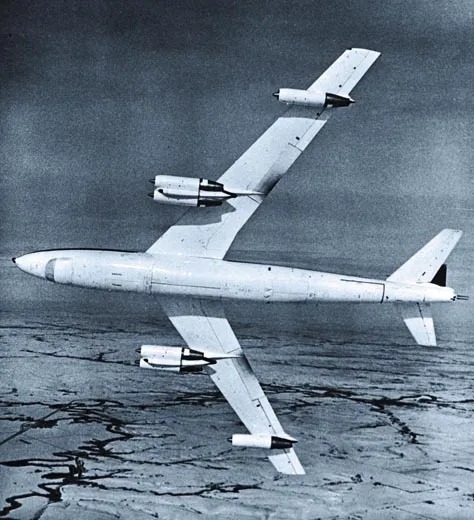
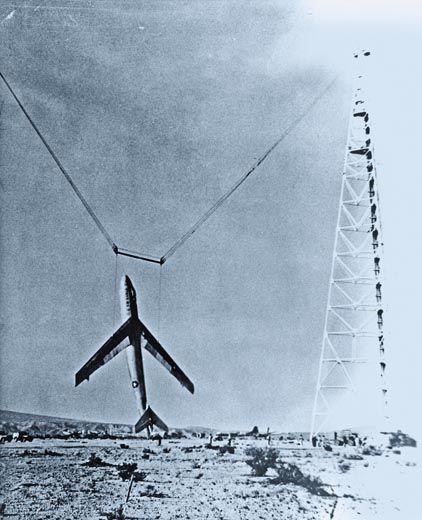
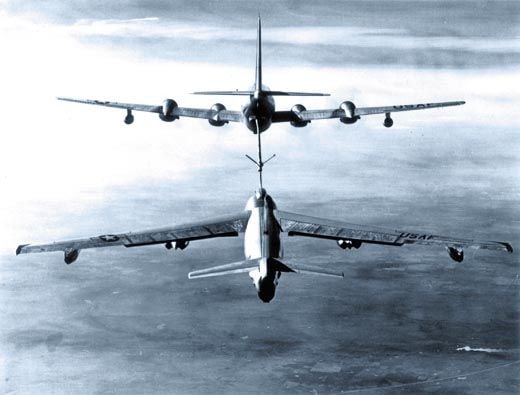
/https://tf-cmsv2-smithsonianmag-media.s3.amazonaws.com/filer/Arch_B47_Gal_D_JJ09.jpg)
/https://tf-cmsv2-smithsonianmag-media.s3.amazonaws.com/filer/Arch_B47_Gal_F_JJ09.jpg)
